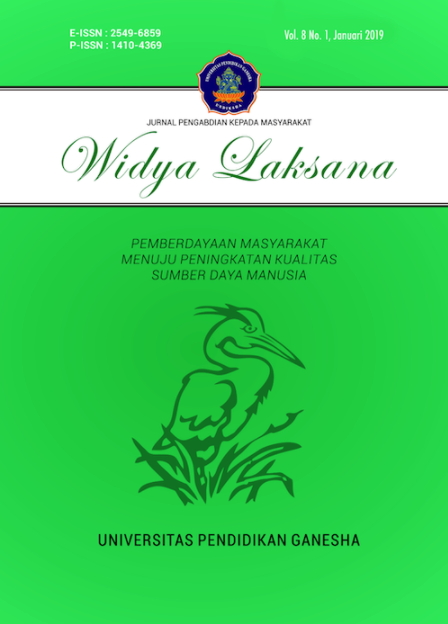PELATIHAN MERANCANG INSTRUMEN ASESMEN HIGH ORDER THINKING SKILLS PADA GURU-GURU SD DI KECAMATAN LAWEYAN SURAKARTA
DOI:
https://doi.org/10.23887/jwl.v9i1.16660Abstract
k
Masalah yang dihadapi saat ini, terkait dengan keberadaan kurikulum 2013, adalah masih kurangnya pemahaman para pelaksana pendidikan yaitu guru-guru dalam memahami kurikulum 2013 khususnya yang berkaitan dengan penilaian atau asesmen. Secara spesifik adalah tentang kemampuan penyusunan instrumen penilaian berbasis High order thinking skills (HOTS). Hal ini terlihat dalam kegiatan PPL mahasiswa di sekolah dasar dan pada kegiatan sertifikasi guru melalui program PPG (Program Pendidikan Profesi Guru). Para guru maupun calon guru masih mengalami kesulitan dalam menyusun instrumen berbasis HOTS.
Pentingnya instrumen asesmen/penilaian dalam kegiatan proses pembelajaran merupakan hal yang perlu mendapat perhatian serius, mengingat penilaian adalah bagian integral yang tidak terpisah dari proses pembelajaran.Dalam merancang instrumen asesmen yang dapat mendorong peserta didik untuk mengembangkan kemampuan berpikir kritis bukanlah hal yang mudah. Hasil penelitian menemukan bahwa 55 % soal-soal tes yang digunakan oleh 36 guru yang mengajar matematika, IPA, IPS, bahasa, pada tingkat sekolah dasar sampai menengah, sebagian besar guru tidak merancang instrumen yang mengukur higher order thinking skills. Instrumen yang digunakan cenderung hanya mengukur kemampuan mengingat fakta. (Burns, 1985, Boyd, 2008). Higher order thinking skills adalah keterampilan siswa pada tingkatan 4 (analyzing) sampai 6 (creating) pada Taxonomy Bloom ranah kognitif. Sebagai upaya untuk meningkatkan profesionalisme guru dalam mengajar, diperlukan pelatihan dalam merancang instrumen penilaian berbasis HOTS. Adapun metode yang digunakan dalam pelatihan berupa penyampaian materi, dengan menggunakan ceramah, tanya jawab, penugasan diskusi, praktik merancang instrumen penilaian berbasis HOTS.
Pelatihan ini melibatkan guru di SDN Kecamatan yang berjumlah 30 guru dan dilaksanakan selama dua hari. Hari pertama penyampaian materi penilaian serta contoh-contoh instrumen dan hari kedua praktek penyusunan instrumen penilain berbasis HOTS. Para peserta sangat antusias dalam mengikuti pelatihan dapat dilihat dari jumlah kehadiran yang 100% hadir. Kemampuan peserta merancang instrumen asesmen berbasis HOTS skor reratanya minimal 75.
Kata Kunci: Penilaian, Instrumen, High order thinking skills
ABSTRACT
The problem faced today, related to the existence of the 2013 curriculum, is that there is still a lack of understanding of education implementers, namely teachers in understanding the 2013 curriculum, especially those related to assessment or assessment. Specifically, it is about the ability to prepare assessment instruments based on High order thinking skills (HOTS). This can be seen in the PPL activities of students in elementary schools and in teacher certification activities through the PPG (Teacher Professional Education Program) program. Teachers and prospective teachers still have difficulties in compiling HOTS-based instruments.
The importance of assessment instruments / assessment activities in the learning process activities is a matter that needs serious attention, considering that assessment is an integral part that is not separate from the learning process. In designing assessment instruments that can encourage students to develop critical thinking skills is not easy. The results of the study found that 55% of the test questions used by 36 teachers who taught mathematics, science, social studies, language, at the elementary to secondary level, most teachers did not design instruments that measure higher order thinking skills. The instruments used tend to only measure the ability to remember facts. (Burns, 1985, Boyd, 2008). Higher order thinking skills are the skills of students at level 4 (analyzing) to 6 (creating) in the Taxonomy Bloom cognitive domain. In an effort to improve teacher professionalism in teaching, training is needed in designing HOTS-based assessment instruments. The method used in the training was in the form of delivering material, using lectures, question and answer, discussion assignments, and the practice of designing HOTS-based assessment instruments.
This training involved teachers in the SDN Kecamatan, totaling 30 teachers and was held for two days. The first day of presentation of assessment material and examples of instruments and the second day of the practice of preparing HOTS-based assessment instruments. The participants were very enthusiastic in participating in the training can be seen from the number of attendance which was 100% present. The ability of participans to design HOTS based assessment instruments the average score is at least 75.
Keywords: Assessment, Instruments, High order thinking skills
References
A.A. anwar Prabu mangkunegara. (2001). Manajemn Sumber Daya Manusia Perusahaan.Bandung Rosdakarya.
Doganay, A. And Bal, A. P. (2010) The Measurement of Students’s Achievement in Teaching Primary School Fifth Year Mathematics Classes. Educational Science: Theory & Practice, 10(1), pp.199-215
Hasibuan, Malayu SP, 2003. Manajemen Sumber Daya Manusia. Edisi Revisi, Bumi Aksara, Jakarta.
Heong, Y.M., Othman, W.D., Md Yunos, J., Kiong, T.T., Hassan, R., & Mohamad, M. M. 2011. The Level of Marzano Higher Order Thinking Skills Among Technical Education Students. International Journal of Social and Humanity, Vol. 1, No. 2, July 2011, 121-125
Resnick, L. B. (1987). Education and learning to think. Washington, D.C: National Academy Press.
Downloads
Published
Issue
Section
License
Authors who publish with the Widya Laksana agree to the following terms:- Authors retain copyright and grant the journal the right of first publication with the work simultaneously licensed under a Creative Commons Attribution License (CC BY-SA 4.0) that allows others to share the work with an acknowledgment of the work's authorship and initial publication in this journal
- Authors are able to enter into separate, additional contractual arrangements for the non-exclusive distribution of the journal's published version of the work (e.g., post it to an institutional repository or publish it in a book), with an acknowledgment of its initial publication in this journal.
- Authors are permitted and encouraged to post their work online (e.g., in institutional repositories or on their website) prior to and during the submission process, as it can lead to productive exchanges, as well as earlier and greater citation of published work. (See The Effect of Open Access)



